The Ranking Module is used to create questions in which students can rank items (text or images) and be graded on whether they put them in the right order.
Getting Started
- To insert a Ranking Module into the Question Text section, click on the Ranking Button, or the button that contains an A, Z, and a downward arrow.

- Once inserted into the Question Text section, the module will always appear as an image of an item list and a sorted item list, as exemplified in the screenshot below:
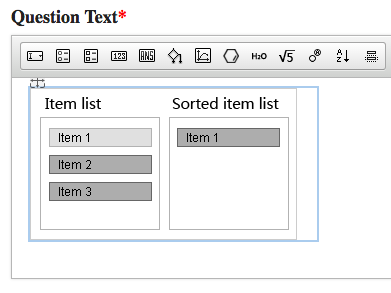
- To enter the Ranking Module Editor, double click on the image of the Item List and the Sorted Item List.
The Ranking Module Editor consists of two tabs: Question/Answer tab, in which authors create the items to be used in the ranked list, and set the question’s answer by placing the uploaded items in order; and the Feedback tab, in which authors can write feedback that the student sees depending on how she ranks the items.
The Ranking Module Editor also has a Save button, which you can use to save your work and exit the module, and a Cancel button, which will allow you to exit the module without saving.
Please note that the system will not allow you to save the module unless an answer has been programmed into the Question/Answer tab. Also, once you hit the Save button, the module will close.
Setting Up The Question
Set up for Ranking Questions occurs on the Question/Answer tab, where you can create your ranked items, and tell the system how they are correctly ranked.
To set up a question, do the following steps:
- Choose whether you want your list to contain images or text. You cannot mix images and text items.
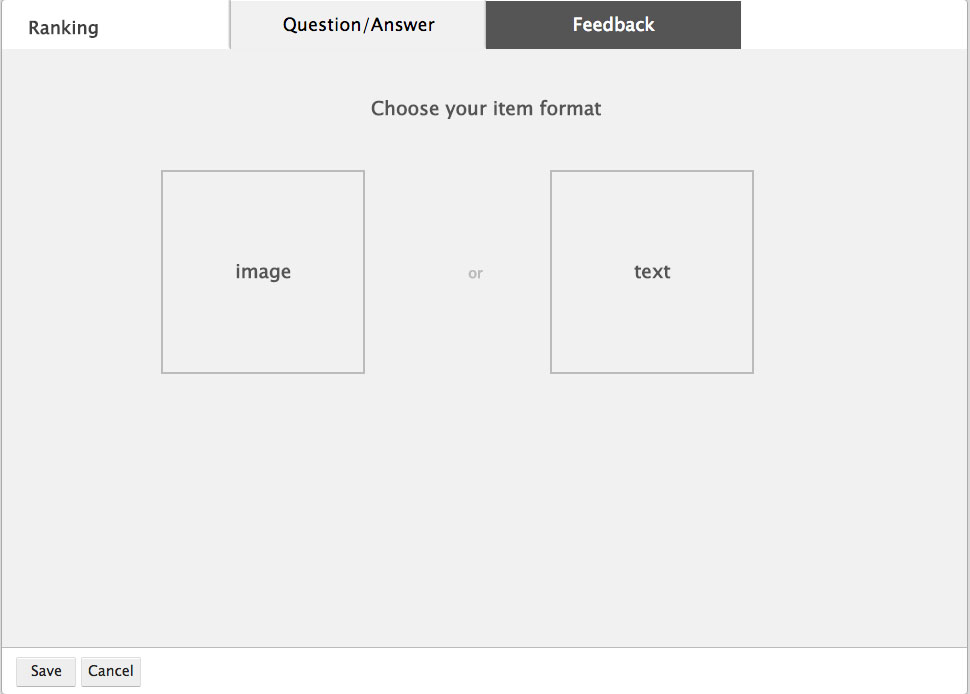
- Determine if you want your items to be raked horizontally or vertically. Select whichever format best suits your list.

Note that both the vertical and horizontal ranking structures allow you to upload and insert the same number of items.
Currently, you can only rank text items in vertical lists. Similarly, you can only rank image items in horizontal lists.
Ranking Text Items
There are slight differences between uploading text and image items. Currently, you can only rank text items in vertical lists.
To create a ranking list with text, do the following:
- In the editable text field of the Question List section, begin typing your text item.
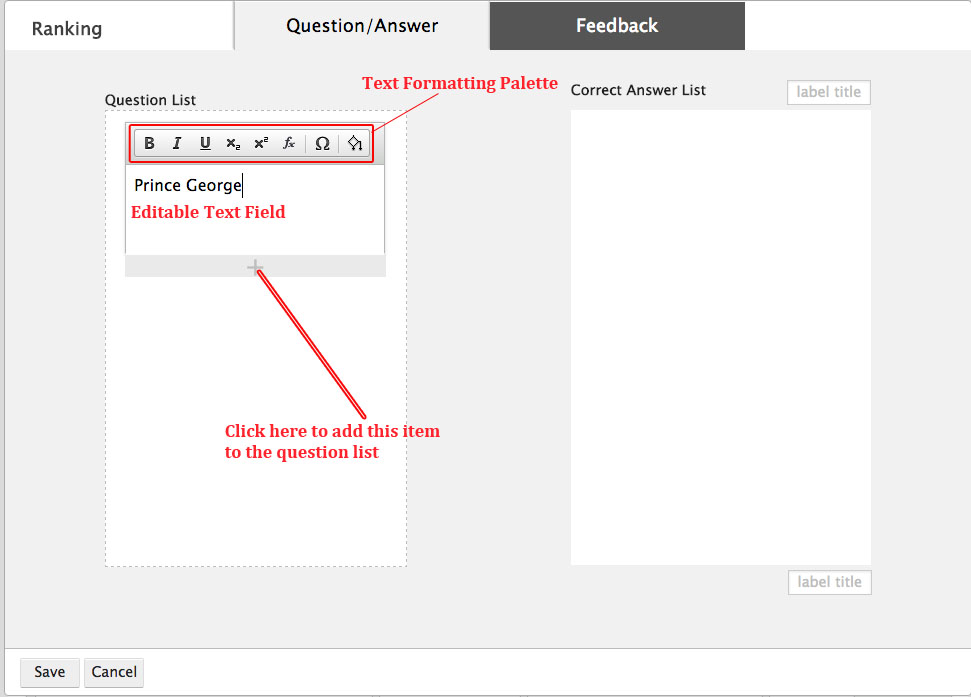
- Use the Text Formatting Palette to format your text. From left to right, the Text Formatting Palette allows you to do the following:

- Bold text
- Italicize text
- Underline text
- Insert a subscript
- Insert a superscript
- Insert a math expression using LaTeX
- Insert a special character
- Insert an algorithmic variable (for an in depth look at algo, please see the “Algorithmic Variable” documentation)
- Click the + button at the bottom of the editable text field to add your item to the Question List.
- Once you add an item to the Question List, a numbered spot will appear in the Correct Answer List. There will be an equal number of spots as there are items in the Question List.
- To delete an item, scroll over it. An X will appear in the upper right hand corner. Click on the X to delete the item.
- Currently, you cannot edit a tile that you’ve already created. If you need to correct an existing tile, delete it and create a new one.

- If desired, tell the system to randomize the order of the items in student view by selecting "Scramble answer choices" in the lower right-hand corner.

Ranking Image Items
Currently, you can only rank image items in horizontal lists.
To create a ranking list with images, do the following:
- In the Question List, click on the square with the plus sign.

- This will open up the Image Upload Window, pictured below, which allows you to access all of the images uploaded to the image folder associated with your account:
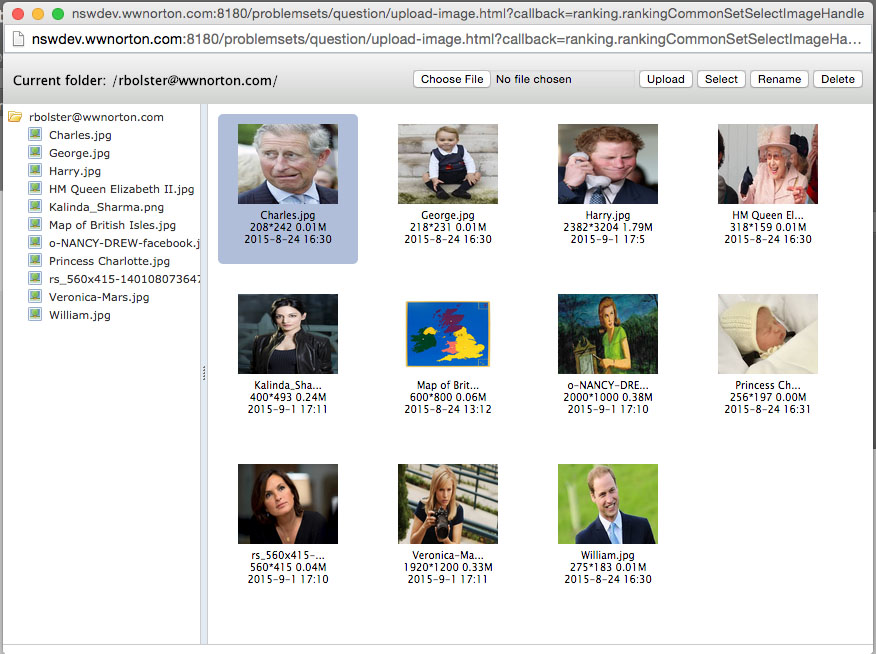
- Select the image you want to use in your Ranking Question.
i. Upload the image you would like to include in the Item list by clicking on the “Choose File” button at the top of the window. Once you select the image from your computer, click on the “Upload” button in the top right corner to upload it to your SW5 folder.
ii. Select a previously uploaded image from your folder by clicking on the appropriate thumbnail.
iii. You can rename or delete images that are uploaded to your folder using the “Rename” and “Delete” buttons at the top right corner of the window.
iv. You can only access images that are uploaded to the folder associated with your account. You cannot access images that are uploaded by another user.
- Double click on the image you would like to insert into the Question List. This will close the Image Upload Window and will take you back to the Question/Answer tab. Your image will be in the Question List.
- Add a caption to your image. Currently, the system does not have a character limit for captions, but check with your Editor for best practices.
- Once you add an item to the Question List, a numbered spot will appear in the Correct Answer List. There will be an equal number of spots as there are items in the Question List.
- To delete an item in the Question List, move your cursor over it. An X will appear in the upper right hand corner. Click on the X to delete your item.
- Currently, you cannot replace the image in a tile that you’ve already created. Instead, create a new tile and insert the desired image into it. The caption may be edited at any time if the tile is in the Question List.
- There is not a limit as to how many images you can add to your Question List. If you add more than four, an arrow will appear on the right hand side of the Question list that allows you to scroll through the image items you have uploaded. Although you can add an unlimited number of items, check with your editor for best practices.
- If desired, tell the system to randomize the order of the items in student view by selecting "Scramble answer choices" in the lower right-hand corner.
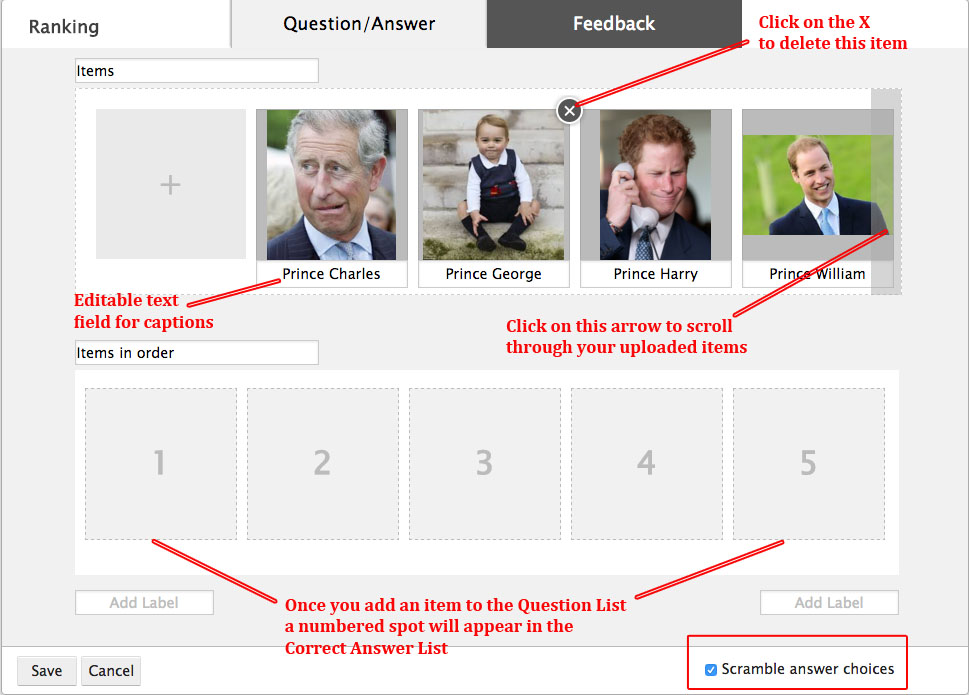
Defining the Answer
You can define the correct answer in Correct Answer List on the Question/Answer tab. The Correct Answer List tells the system the pattern of items it should recognize as correct.
To set the correct answer, do the following:
- Determine the order in which you want students to rank the correct answer. In the editable text fields beneath the Correct Answer List, add labels to indicate how the items should be ranked.

- Place the items on the numbered tiles in the order in which they are correctly ranked.
Things to keep in mind when setting the correct answer:
- You can only use each item in the correct answer once. Once an item is dragged to the Correct Answer List, it will be removed from the Question List.
- Once an item is placed in the Correct Answer List, you can move it to a different numbered slot. You can also move it between two items, or switch it with another item by clicking on it and dragging it to its desired location.
- In the event that you want to remove an item from the Correct Answer List, scroll your mouse over it so that an X appears in the top right hand corner. Click on the X to return the item to the Question List.
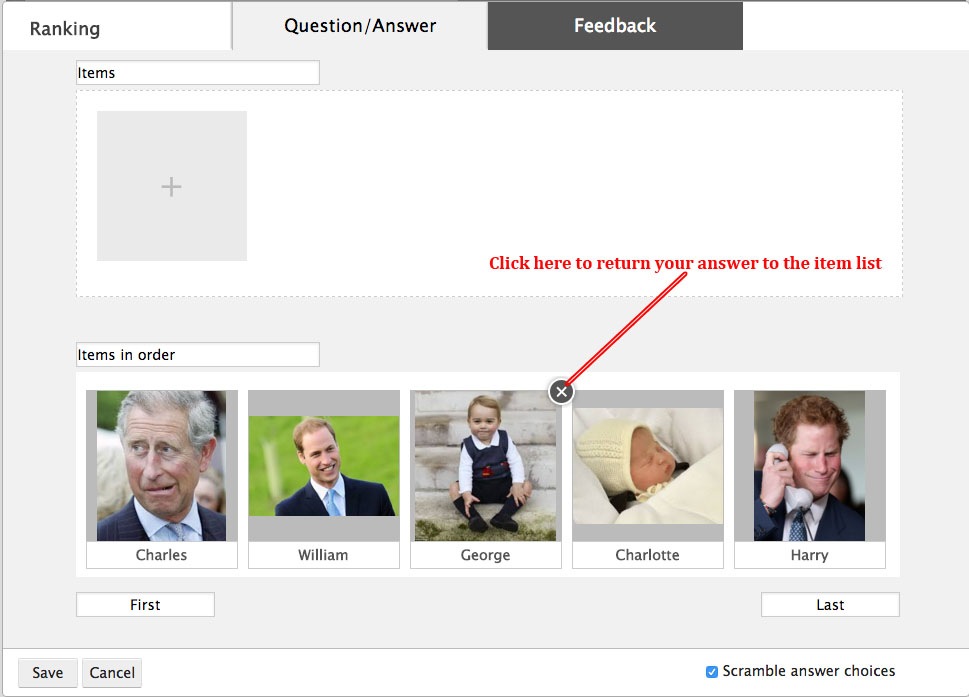
- You do not need to use all of the items in the Question List in your correct answer. However, all items in the Question List will be available to students as answer choices. To permanently remove an item, you must remove it from the Question List.
- Once you have placed items in the Correct Answer List, the module allows you to successfully save your question.
Creating Feedback
Smartwork5 determines whether a student’s answer is correct or not by recognizing the pattern you specify in the Answer tab. If a student matches the pattern in the Answer tab, the system recognizes the answer as correct. If the student fails to match that pattern, the system recognizes the answer as incorrect.
The Feedback section allows you to write Feedback that the student sees when she triggers these correct and incorrect patterns.
Each Feedback tab contains a text editor, which allows you to add text and other multimedia to the feedback.

Important Note: Copying and pasting text from a Word Document into Smartwork5 could insert formatting that will corrupt the module. Please enter the text directly into the Text Editor, or copy and paste from a plain text document.
The Media Palette allows you to insert multimedia into the Feedback tab.

From left to right, the Media Palette allows you to do the following:
- Insert chemical equations
- Insert symbolic (math) equations
- Insert algorithmic variables
- Insert image files
- Insert music files
- Insert video files
- Insert hyperlinks
- Remove the hyperlinks
The Text Formatting Palette allows you to format the text in answers, as well as add special characters.

From left to right, the Text Formatting Palette allows you to do the following:
- Bold text
- Italicize text
- Underline text
- Insert subscripts
- Insert superscripts
- Insert math equations **This tool is being phased out. To insert math equations, please use the symbolic equation tool.
- Insert special characters
- Remove any formatting applied to the text
Furthermore, the Feedback Formatting Palette allows you to do the following:

- Insert tables
- Insert line breaks
- Edit text in full screen mode
Correct and Default Feedback
The Feedback tab will initially have a tab for Correct feedback, which a student sees whenever she matches the pattern in the Answer tab. It will also have a tab for Default feedback, which a student will see whenever she creates an unspecific pattern that does not correspond to what is in the Answer tab. Default feedback will trap for all incorrect answers unless otherwise specified in a Specific feedback tab, which will be discussed in the next sections.
To set Correct feedback, do the following:
- Type up what you want the student to see when she correctly ranks the items. Add any multimedia you see fit using the palettes in the text editor.
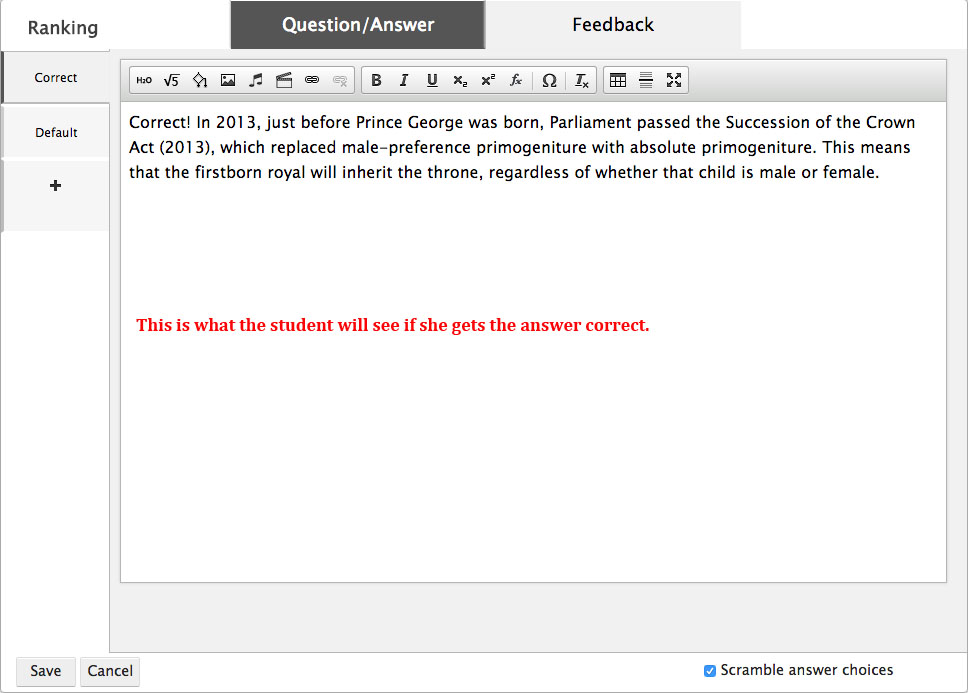
- Save the question.
- Go to preview mode in the Question Editor. Check that the Feedback is working correctly by recreating the correct answer in the preview window.
You should see the feedback you wrote in the correct feedback tab:
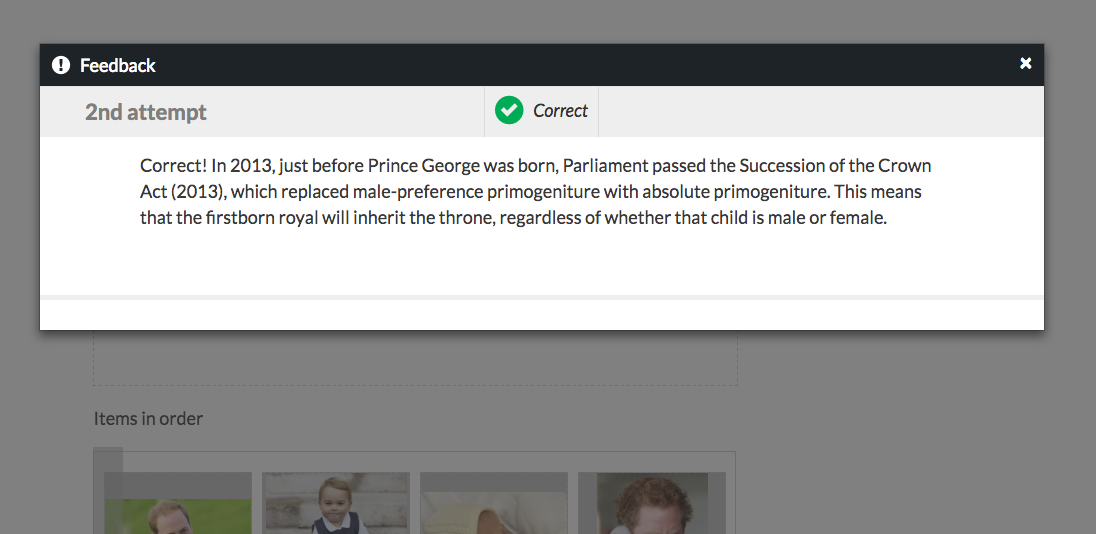
To set Default feedback, do the following:
- Type up what you want the student to see when she incorrectly ranks the items.
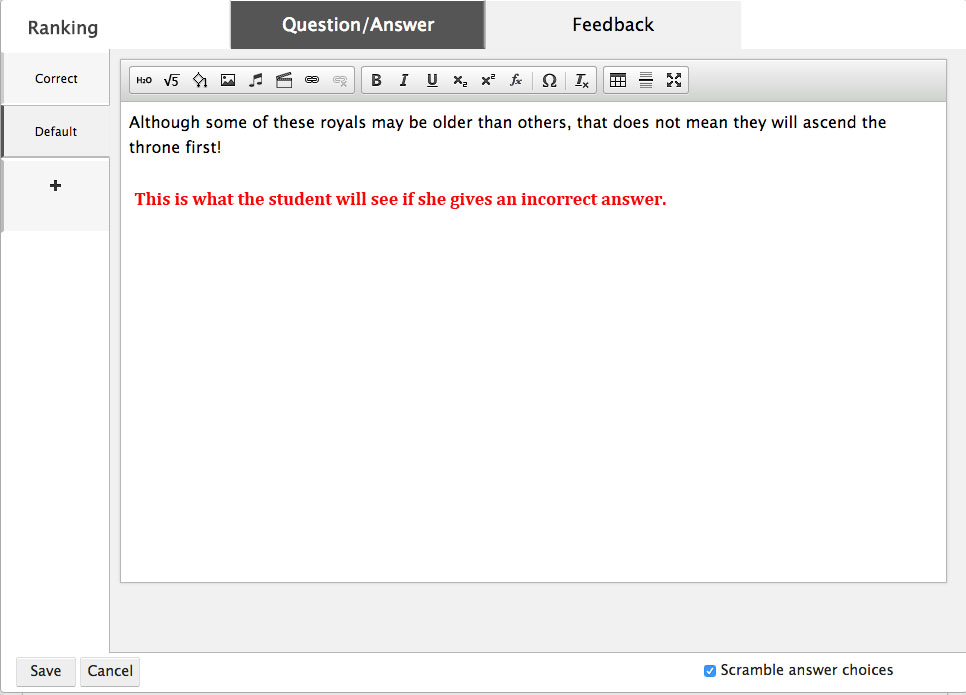
- Save the question.
- Go to preview mode in the Question Editor. Check that the Feedback is working correctly by recreating a pattern that is NOT correct in the preview window.
You should see the Feedback you created in the Default Feedback tab:
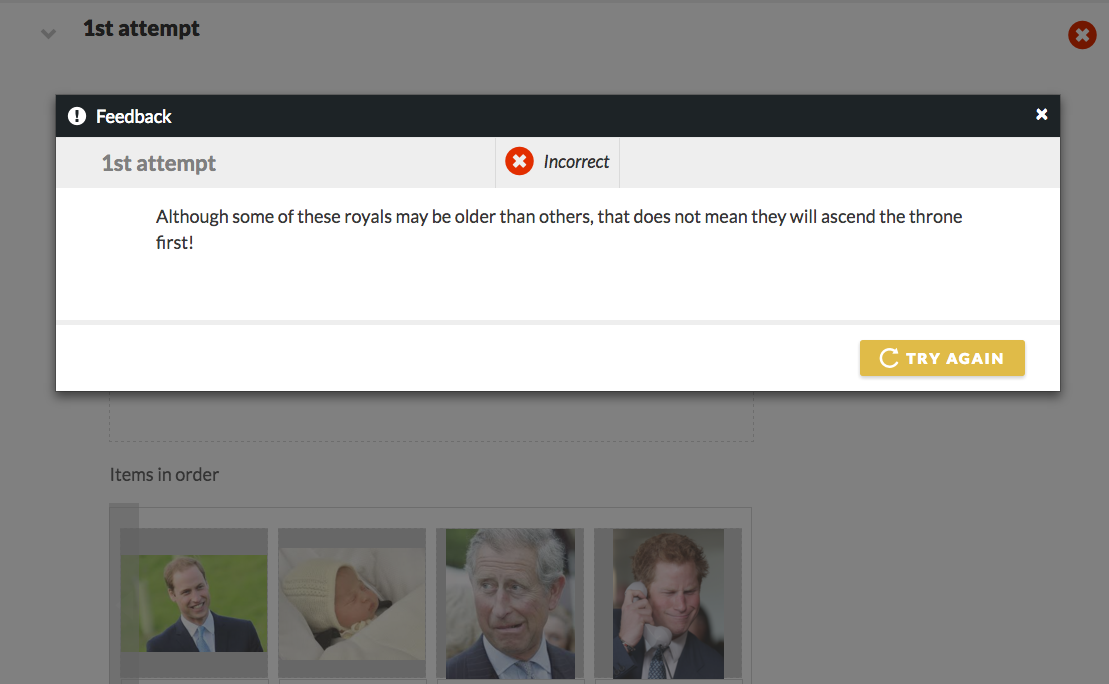
Specific Incorrect Feedback
You can create feedback for specific incorrect answers by using the Specific Incorrect feedback tabs.
When creating specific incorrect patterns, you can either use all of the items in the item list, or only use some of the items in the item list. Feedback that only uses some of the items in the item list can trigger Cascading Feedback, which will be discussed in the next section.
To set specific incorrect feedback using all the items in the item list, do the following:
- Click on the tab with the plus sign to add a Specific Incorrect feedback tab.

- In the tab’s Sorted Item List, create the specific incorrect pattern.
- Type up what you want the student to see when she triggers this specific incorrect pattern.
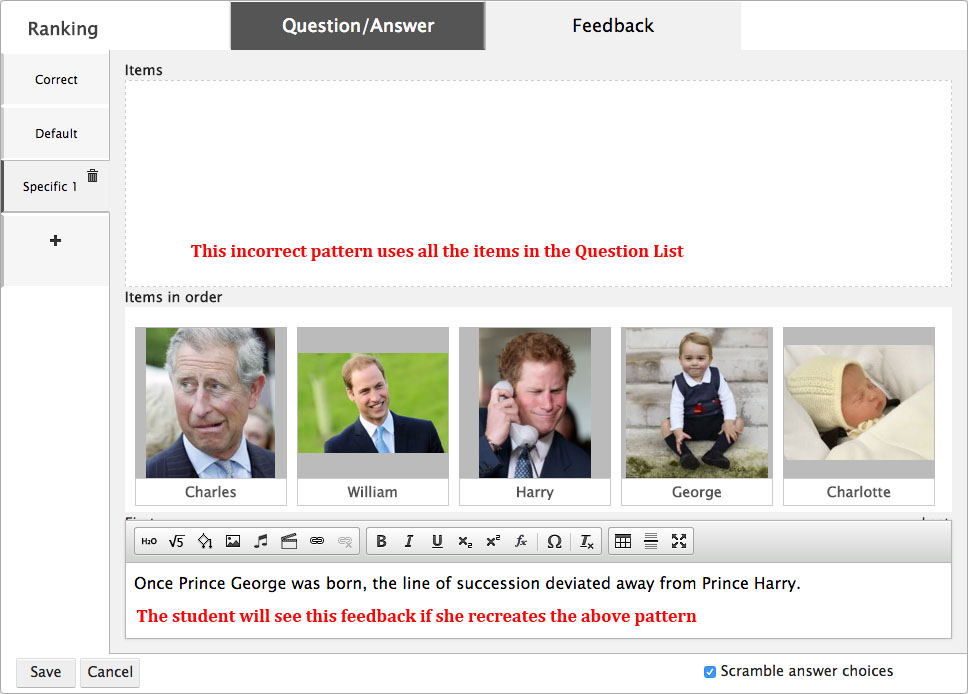
- Save the question.
- Go to preview mode in the Question Editor. Check that the Feedback is working correctly by recreating the specific incorrect pattern in the preview window. You should see the Feedback you created in the Specific Incorrect Feedback tab:
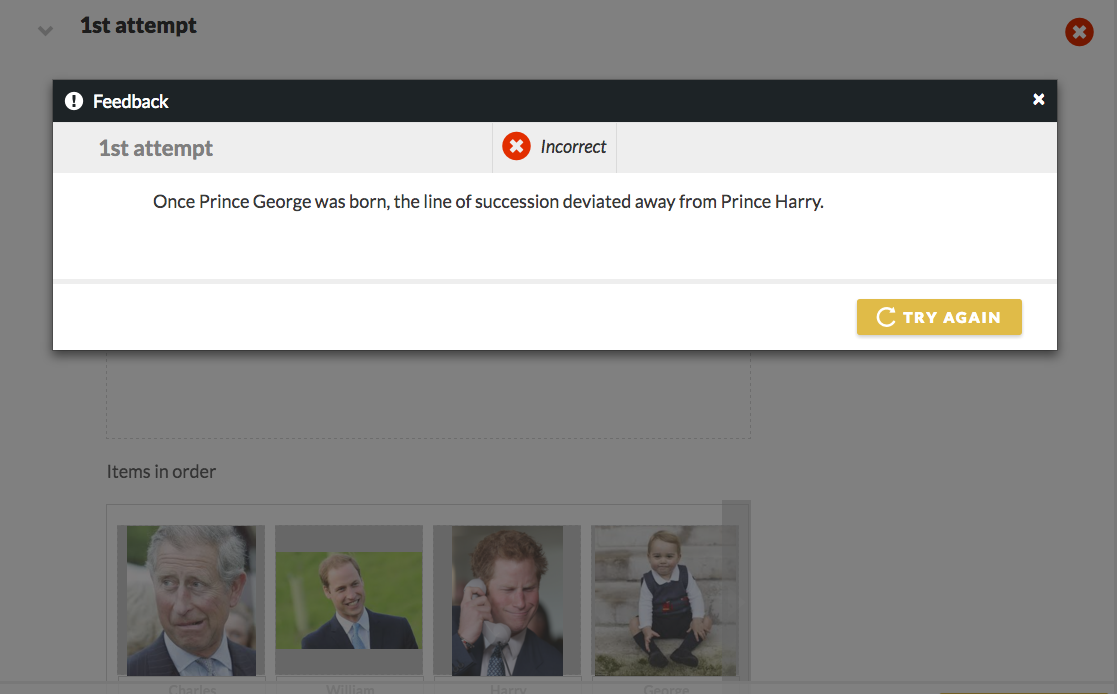
Cascading Incorrect Feedback
As previously mentioned, Smartwork5 recognizes an answer as correct or incorrect by recognizing patterns specified by the author. Patterns can use all of the items in the Item List, or they can use only some of the items.
When incorrect patterns use only some of the items, the system recognizes patterns by assessing where each item is in relation to other items in the Sorted Item List.
Applying How the System Recognizes Patterns to Feedback
Because the system creates patterns by recognizing where an item is in relation to other items, authors do not need to create full patterns to create feedback.
In this example, the author creates feedback for when students mistakenly rank Prince William in front of Prince Charles. By only placing those two items in the Sorted Item List, the author tells the system to display the feedback only when William is ranked in front of Charles.
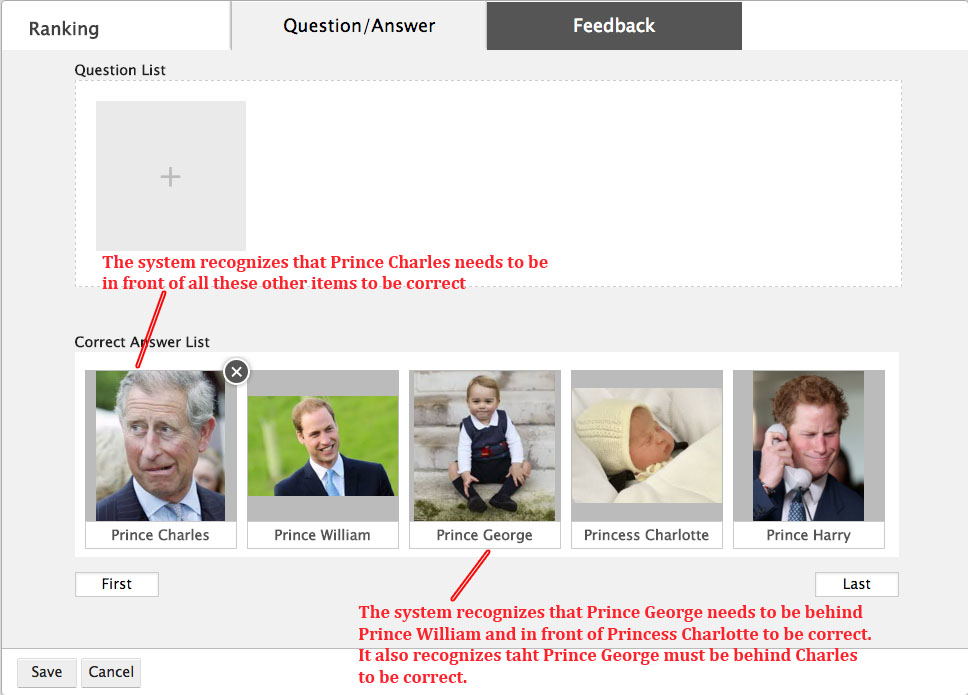
When the student answers the question, it does not matter how many items are between William and Charles. As long as the student places William in front of Charles, the system will display the feedback that corresponds to that pattern.
Layering Patterns and Cascading Feedback
The system allows authors to layer feedback if the student triggers multiple partial patterns. This is called Cascading Feedback. Note that if the student’s response exactly matches an incorrect pattern that uses all the tiles, only that one feedback will be displayed.
To create Cascading Feedback, do the following:
- On a Specific Feedback tab, create a pattern using two or more items. For simplicity’s sake, this example will only use two items.
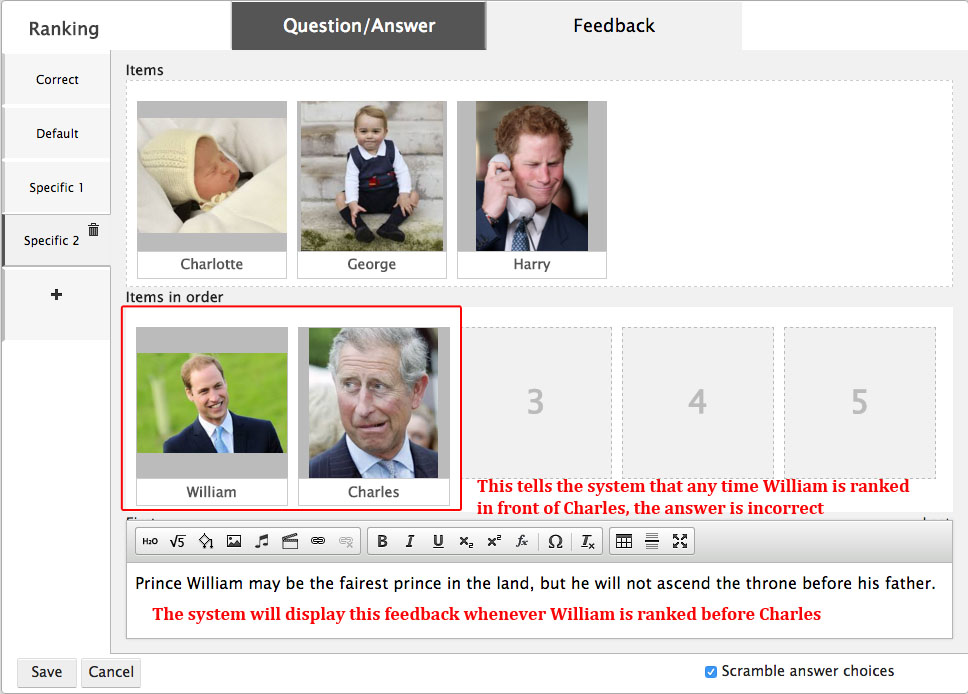
- Go to preview mode in the Question Editor. Check that the Feedback is working correctly by recreating the incorrect pattern in the preview window.

- Go back to the Module Editor and create another incorrect pattern.

- Go to preview mode in the Question Editor. Check that the Feedback for this incorrect pattern is working correctly by recreating the incorrect pattern in the preview window.

- Test the Cascading Feedback by simultaneously fulfilling both incorrect patterns. In this instance, that means placing William in front of Charles and Harry in front of Charlotte.
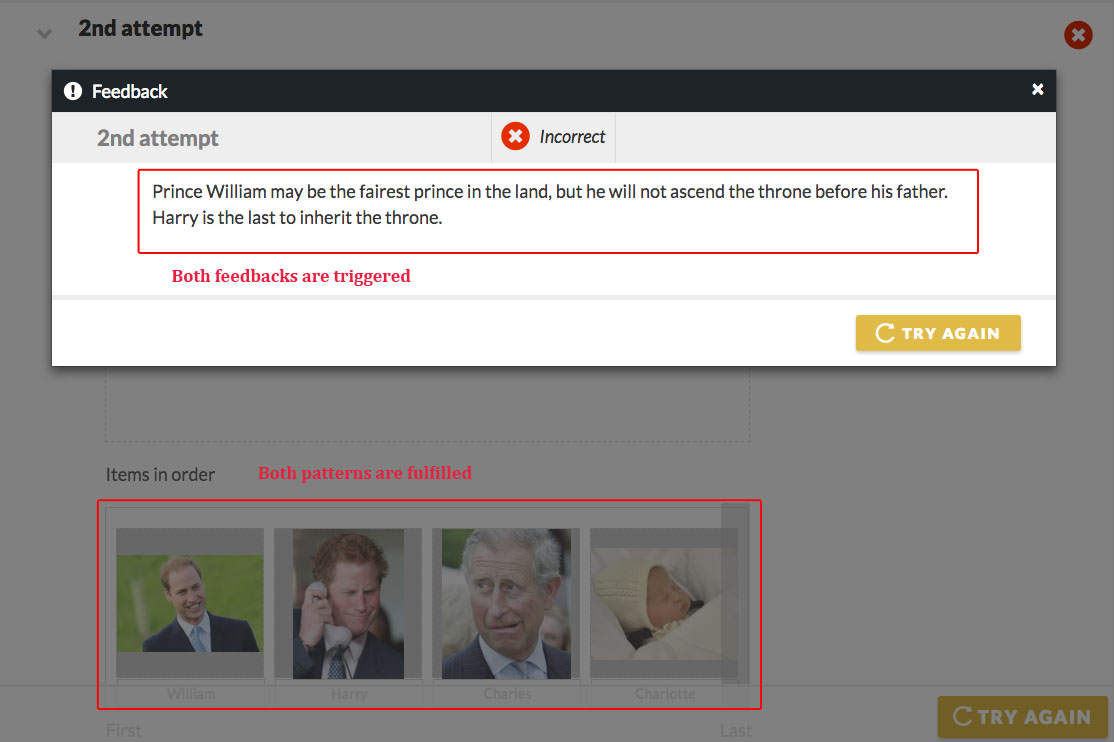
Because the system assesses items relative to each other, there are other ways to trigger this set of Cascading Feedback. For example, the student could place Harry between Charles and William. As long as Charles is behind William, and Harry is in front of Charlotte, the student will see this specific set of feedback.